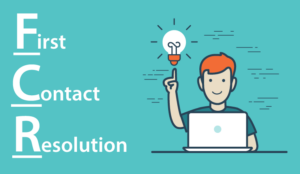Dick Bourke at Scorebuddy shares his advice for using First Call Resolution (FCR) as a metric in the contact centre.
The most important call center focus is on providing good customer service calls. But how do you know if your contact center is offering quality customer experiences?
You have to take an in-depth look at your call center metrics—such as first call resolution—to see if your agents are handling customers in a way that matches their expectations.
First call resolution (FCR) reveals whether or not your team is efficient at serving your customers the right resolution, the first time they contact you.
It’s an essential metric for customer satisfaction, and more complicated than you may think. Furthermore, it can highlight what you do well and where you need work.
What Is First Call Resolution?
So, what is first call resolution? It’s fairly self-explanatory. FCR is a metric that reveals how well your contact center resolves your customers’ problems, questions, and needs during the first interaction via any communication channel. The key to first call resolution is that no follow-up (or escalation) is required.
According to the International Customer Management Institute (ICMI), first call resolution is the “percentage of initial calls that do not require any further contact to address the customer’s reason for calling.” Ideally, FCR is defined based on the customer’s perspective.
First call resolution is a measure of customer satisfaction that is usually displayed as a rate: the higher your rate, the more satisfied your customers tend to be.
FCR is also a measurement of operational performance and efficiency, helping you save money by ensuring your agents spend less time on unnecessary customer support.
While first call resolution sounds simple, it’s actually quite complicated, which makes it one of the most difficult KPIs to assess correctly. The key is clearly defining what FCR means for your business and then developing a framework to measure it consistently.
But first, let’s take a look at the importance of first call resolution.
Why Does First Call Resolution Matter to Customer Service Teams?
Customers want companies to take care of their needs quickly. In fact, 40% of customers want agents to take care of their needs faster, and they do NOT want to have to repeat themselves to multiple support agents.
And that only scrapes the surface of the importance of first contact resolution customer service.
Companies that continually measure first call resolution outperform their competitors in many areas. According to The Ascent Group, by measuring FCR for a year or more, you can improve your performance by up to 30%.
Here are a few specifics about how FCR can help your growth-minded business.
1. Improved Customer Retention
Bad customer service experiences cause 82% of customers to leave a company. And unresolved complaints are one of the most common customer pain points.
Poor first call resolution can mean the difference between retaining a customer and losing them.
2. Increased Customer Satisfaction
Dissatisfied customers will tell up to 15 other people about their negative experiences with your business. So it’s essential to make every interaction as positive and helpful as possible. By addressing customer concerns swiftly, you can transform unhappy customers into satisfied customers.
3. Greater Customer Spend
For better customer service, people are willing to spend 17% more. Plus, 93% of customers are likely to make repeat purchases from companies they feel provided excellent customer service.
4. Decreased Contact Center Costs
It is five to twenty-five times more expensive to invest in acquiring a new customer than to retain an existing one. Focusing on providing best-in-class customer service for your existing customers through first call resolution will help you decrease your internal contact center costs.
5. Better Call Center Efficiency
Solving your customers’ problems the first time they contact you—whether by phone, email, chat, or social media—will eliminate the need for repeat calls regarding the same issue. This means that your agents will deal with fewer calls, chats and emails, resulting in shorter wait times and more productive and efficient customer service teams.
How Do You Measure First Call Resolution?
To measure first call resolution, you first need to customize it for your company. It should be tailored to your agents’ skill sets, communication channels and organizational best practices.
For example, some businesses only apply FCR to phone calls (live interactions) where an agent can communicate directly with a customer and resolve the interaction. For other businesses, live chat, email, and social media are included in FCR.
There are also discrepancies on whether or not customer service inquiries that require a callback, transfer to another source of support, or escalation to a manager count as first contact resolution.
It’s up to your company how you want to define FCR. The key is to come up with your criteria by answering a few questions:
- What channels does FCR apply to?
- What does it mean to sufficiently resolve a customer’s problem?
- Does a call/contact escalation negate FCR?
- How does a standard callback requirement work within FCR?
- Does a customer contacting the wrong department affect FCR?
- What constitutes a repeat call?
- How do you count abandoned calls due to wait times before an agent interaction?
The more specific you can be about what constitutes a resolved call and what doesn’t, the more accurate and effective your first call resolution rate will be.
First Call Resolution Rates
To quantify first call resolution, use the first call resolution rate formula. To determine your FCR rate, simply divide the total number of customer cases resolved on first outreach by the total number of cases received that day, week, month, quarter, or year.
FCR = (Total Resolved Cases / Total Number of Cases) x 100%
Good FCR Rates
What exactly is a good FCR rate? According to a range of reports, the industry standard is between 70 and 75%. This means that 25-30% of all customer communications you receive are repeat calls about the same issue.
In general, the higher your FCR rate, the better. However, you don’t want a high FCR rate at the expense of a high average talk time (ATT) or average handle time (AHT).
Doubling or tripling the time you spend communicating with customers in order to improve your first contact resolution rates decreases your efficiency and many of the benefits you would receive from improved FCR.
Improving Your First Call Resolution Rate
To improve your FCR rate, follow these best practices when it comes to your customer service experience.
Set Up Your CRM to Track Customer Service
To determine which calls were resolved the first time and to help you calculate FCR consistently, you first need a way to track all of your support interactions.
Your CRM system or customer service software should be able to track customer support tickets, calls, emails, live chats, and more. And it should offer omnichannel support, so you don’t miss situations where a caller asked for additional help via live chat or followed-up with an email.
Offer Omnichannel Support
You have to look at the entire picture when it comes to first contact resolution.
According to Zendesk, 35 percent of customers expect to be able to contact the same customer service agent through any communication channel, and 87% want a consistent experience. To improve FCR, you need to be prepared to meet your customers where they are at.
Invest in customer service and QA software that simplifies omnichannel support. You should be able to track your customers no matter how they contact you, document their interactions, and solve their issues without needing to open multiple tickets.
Respond Quicker
One of the keys to improve first call resolution is to respond quickly. 90 percent of customers expect nearly instant responses from companies, and 60% of customers define “immediate” as ten minutes or less.
That’s why 73% of consumers say that valuing their time is the most important thing a company can do when providing customer service, according to Forrester.
So, it’s essential that you find a way to answer calls, respond to chats, and reply to emails as quickly as possible.
To respond to customer service inquiries more quickly, you should:
- Staff your team to avoid excessive wait times.
- Train your staff in the knowledge they need to handle support more efficiently.
- Structure your customer service team so that the right individuals with the appropriate knowledge are given the customers that match their skill set.
- Create a knowledge base online with frequently asked questions that customers can find and refer to on their own.
Standardize Common Responses
You can simplify the customer service process—whether via phone, live chat, email, or social media—by creating a list of standard responses for common questions.
These contact scripts can help your agents more quickly and easily respond to common issues. These standard responses can also ensure that typical issues are resolved to the customer’s satisfaction, which improves FCR.
Ask “Is There Anything Else?”
Every customer interaction should end with your agent asking, “Is there anything else I can help you with?”
The goal should be to ensure that you have completely solved all of the customer’s issues and that no new problems were created throughout the interaction.
If you ask this final question, not only will your customers view you in a more favorable light, but you’ll collect data on how well your customer support works.
Implement Contact Center QA Forms
The key to successfully monitoring the quality of your call center agents and their customer interactions is to implement call center QA forms.
These forms provide essential feedback that can be used to train and motivate your agents, identify contact center trends, and reveal areas where processes can be improved.
To get started, you need to create a completely customizable QA form, such as Scorebuddy’s Scorecards, which you can iterate, change, and improve based on your customers’ needs.
These scorecards will enable you to evaluate everything, including your agents’ soft skills, call center processes, compliance processes, and customer outcomes.
In this way, you can see what you’re doing well in the contact center when it comes to customer service, and thus make changes to improve first call resolution.
Use CSAT Surveys and NPS to Analyze Trends
After each customer interaction, use a CSAT survey or NPS to see if your customer was truly satisfied. This follow-up outreach can help you understand how satisfied your customers are with your support and what you can do to make improvements.
These scores provide immediate insight into FCR and can prompt your contact center to fix problems immediately.
Continually Improve First Call Resolution
First call resolution is not a one-and-done metric. It’s something that your contact center will have to continually work on. Customer satisfaction is an ever-changing goal that you’ll need to chase every day.

Dick Bourke
Focusing on improving your first call resolution rate by even one percent can equate to saving thousands in operations over the course of a year. And potentially thousands in additional customer spend.
By implementing the best practices we’ve outlined above and creating a detailed contact center QA process, you can reduce repeat calls, increase customer satisfaction, and improve agent efficiency.
This blog post has been re-published by kind permission of Scorebuddy – View the Original Article
For more information about Scorebuddy - visit the Scorebuddy Website
Call Centre Helper is not responsible for the content of these guest blog posts. The opinions expressed in this article are those of the author, and do not necessarily reflect those of Call Centre Helper.
Author: Scorebuddy
Published On: 27th Jan 2020 - Last modified: 28th Jan 2020
Read more about - Guest Blogs, Scorebuddy






 Scorebuddy is quality assurance solution for scoring customer service calls, emails and web chat. It is a dedicated, stand-alone staff scoring system based in the cloud, requiring no integration.
Scorebuddy is quality assurance solution for scoring customer service calls, emails and web chat. It is a dedicated, stand-alone staff scoring system based in the cloud, requiring no integration. 





























